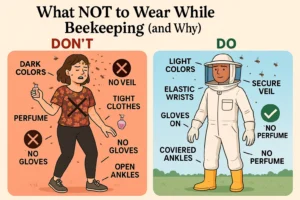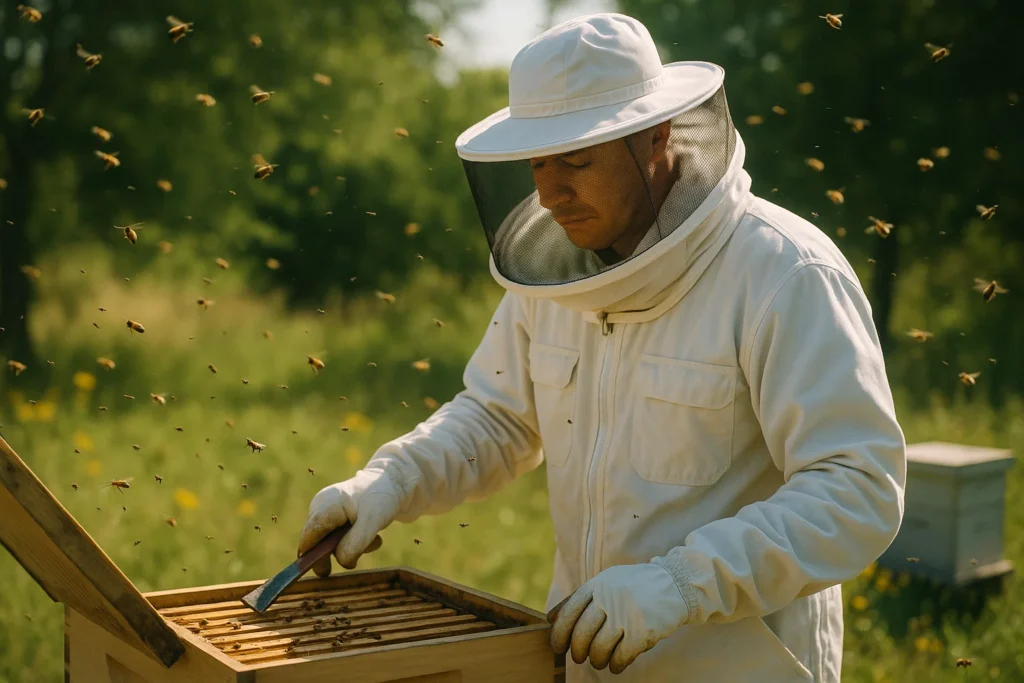
🐝 Gear Up. Stay Safe. Protect the Hive. 🌼
Beekeeping is a rewarding and fulfilling hobby, but it comes with its own set of risks. With bees being naturally defensive of their hives, beekeepers must prioritize safety by choosing and investing in the right beekeeping protective gear. From bee suits to gloves and veils, each piece of equipment plays a crucial role in safeguarding against bee stings and ensuring a successful beekeeping experience. In this comprehensive guide, we’ll delve into the world of beekeeping protective gear, exploring the different options available and providing valuable insights to help you make informed choices.
Before we dive into the specifics of beekeeping gear, let’s first understand why it’s so crucial. Bee stings can cause painful reactions, ranging from minor irritation to severe allergic reactions in some individuals. Moreover, multiple stings can be particularly dangerous, especially for those with allergies. Additionally, bees may become agitated during hive inspections or honey harvesting, increasing the likelihood of stings. Therefore, choosing right beekeeping protective gear is not only about personal comfort but also about minimizing the risk of injury and ensuring a safe beekeeping environment.

Bee suits are the cornerstone of beekeeping protective gear, providing full-body coverage to shield beekeepers from stings. When choosing a bee suit, opt for one made from high-quality materials such as cotton or polyester, with tightly-woven fabric to prevent stingers from penetrating. Look for features like elasticized cuffs, ankle zippers, and veiled hoods for maximum protection and comfort.
In addition to bee suits, beekeepers jackets offer a versatile alternative for those who prefer a lighter and more flexible option. These jackets typically feature a zippered front closure and elasticized cuffs to ensure a secure fit while providing ample protection against bee stings. Made from durable materials such as cotton or polyester, beekeepers jackets offer excellent breathability and comfort, making them ideal for warm weather conditions or shorter beekeeping sessions. With their convenient design and reliable protection, beekeepers jackets are a popular choice among beekeepers of all experience levels. Whether worn alone or paired with other protective gear, these jackets provide an essential layer of defense against bee stings while allowing beekeepers to work with ease and confidence.
Beekeeping gloves are essential for protecting your hands and wrists from bee stings while handling hive frames and bees. Opt for gloves made from durable yet flexible materials, such as leather or canvas, that allow for dexterity and ease of movement. Ensure a snug fit around the wrists to prevent bees from entering the gloves, and consider options with ventilated cuffs for added comfort.
Veils are designed to protect the face and neck from bee stings while maintaining visibility and airflow. Choose a veil with fine mesh that provides excellent visibility without obstructing your view. Look for veils that attach securely to your bee suit or hat to prevent gaps that bees could exploit. Additionally, consider options with adjustable straps or elastic bands for a customized fit.

When selecting beekeeping protective gear, it’s essential to consider factors such as comfort, durability, and personal preferences. Here are some tips to help you choose the right gear for your needs:
Ensure that your beekeeping gear fits snugly but comfortably, with no gaps or loose areas where bees could enter. Pay close attention to sizing charts and consider trying on different options before making a purchase.
Invest in high-quality gear that is built to last. While cheaper options may be tempting, they may not offer the same level of protection or longevity as premium-quality gear.
Look for beekeeping gear with adequate ventilation to prevent overheating, especially during hot weather. Mesh panels, breathable fabrics, and ventilated cuffs can help keep you cool and comfortable during long beekeeping sessions.
Choose gear that is easy to clean and maintain to ensure hygiene and longevity. Removable veils and machine-washable suits can simplify the cleaning process and ensure that your gear remains in top condition.
In conclusion, safety should always be the top priority for beekeepers. By investing in the right protective gear, such as bee suits, gloves, and veils, beekeepers can minimize the risk of bee stings and ensure a safe and enjoyable beekeeping experience. Remember to choose gear that offers a comfortable fit, durability, ventilation, and ease of cleaning to meet your specific needs. With the right protective gear in place, beekeepers can focus on their passion for beekeeping while staying safe and protected.
“In your experience, what beekeeping gear has proven to be most effective in keeping you safe and comfortable during hive inspections?” We’d love to hear your insights!
